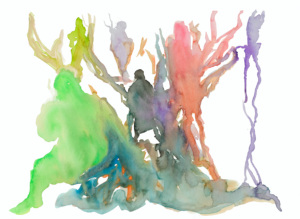Read the companion piece to An Evolutionary Roadmap for Belonging and Co-Liberation.
In my thirteen years working in the field of racial equity, primarily in government, colleagues from the District Attorney’s Office, the library system, and the health department brought to our attention the need to more fully integrate and prioritize healing, trauma-informed work, the arts, and power analyses into teaching methods. In the training we were providing public servants, numerous people expressed the need for more frames and structures that embodied belonging.
Because we do not spend time creating, articulating, and embedding the models and frames we do want that embody health and well-being, our strategies are often partial and at times can be harmful. All of this is strengthened by how sound bites are prioritized over complex and nuanced analyses in communication, how historical amnesia is more valued than critical historical reflection, and how conditioned we are to promote ruptured relationships within ourselves and to each other, our institutions, and our planet.
This essay is part of the work I’ve done to put my experience and analysis in a frame that speaks to the whole health, life, and death of the living systems we are looking to improve and heal. This framework focuses on embodying belonging and co-liberation, and is an attempt to map out an emerging DNA of what belonging would look like when tied to health, spirituality, resilience, and well-being.
This work can be deeply challenging because many of us feel the need for certain kinds of proof of these connections in order to engage with an analysis around them. There is a tension between wanting to use the social sciences to research and define findings from this framework, as it would lead to more healthy societies together, and a solid desire to not root this inquiry from either a place of defense or the need to buy into unhealthy systems and ways of knowing and being.
We spend so much time articulating, framing, and researching things that are symptomatic of and rooted in oppression. We are experts at this. We’ve all been schooled in the modern project that thrives on valuing capital and profits over people and ecosystems, setting up hierarchies within and around all of that based on race, sex, gender, religion, ability, and ideology. White, male, and hetero-centered thinking being the dominant system of our theories and culture—these are the waters we swim in.
john a. powell, director of the Haas Institute for a Fair and Inclusive Society at UC Berkeley, speaks about a systemic “antilife project.” Hardened nation-states bent and dependent on isolating groups as “other” are gaining momentum. Our biological and conditioned needs for certainty cause anxiety and stress. Globally, we’re seeing the dire effects of climate change and illness. Our collective rhythms, which are intrinsically linked to the health of the earth and should be in sync with our ecosystem, are off.
Dr. David Williams, Professor of Public Health at the Harvard T. Chan School of Public Health, speaks of the negative health impact of high levels of incivility and how hostility in the larger environment can create adverse impacts as well. The experience of such angst and “weathering” is not equal across populations. People of color and other marginalized populations live shorter lives, tend to get more sick while young, and experience greater severe illness.
Although many cultures possess a wealth of knowledge around the interconnected worlds of spiritual and social change, the reality is that in today’s “antilife project,” many religious and economic systems have poisoned the waters around this embodied connection that many believe is inherent to what it means to be fully human.
The terms we use to define these concepts, and realities, can be tricky and sometimes, themselves, may produce an othering effect when used. The definitions and language used mean many different things to different people. It’s important to note that terminology and language have been used to erase or deny key aspects of well-being and justice.
Also important is the recognition that people who forefront their engagement with the work of spirituality have been perceived as too often conducting that work at a mostly individual level, without acknowledging, and often outright denying, that we are connected to larger systems that produce racial injustices and outcomes. A damaging belief that many religious and spiritual practices hold is that things like racism and inequities just happen because a [insert any higher power] deemed it so. This denies the socially constructed reality of injustices and helps maintain an innocence to how complicit we actually are in their creation and maintenance. On the other hand, many involved in equity work often leave out a discussion of anything perceived as spiritual because it is seen as synonymous with the negative aspects of religion affecting populations across the globe for centuries.
More movements are choosing to lead with traditionally marginalized people who carry cognitive and spiritual maps together with the wealth and wisdom of their own lived experiences. The entertainment industry is giving rise to marginalized experiences, reflecting liberatory movements and visionary ideas. New forms of knowledge production are on the rise. Decolonization efforts are gaining momentum. Indigenous communities are leading movements in visionary ways that are rooted in ancient cultural and spiritual beliefs.
The impetus for the following framework is the recognition of our need to make better alignments toward what is healthy for all of us. This work centers on and builds from the experiences and paradigms of people of color while also speaking to the fluidity and multidimensionality of our identities, bringing into the fold all populations.
The reality of belonging is that all of these strategies—of leading with ways that shift consciousness, that utilize different modes of critical examination—are already within us. They are not outside of us collectively or individually. They are present and waiting for us to break down the barriers that hold them back from organizing into social arrangements that bring us health.
The Framework
This framework is intended to be a dynamic model that can adapt and evolve. While the work is emergent, I do offer specific key strategies as examples of what the muscles and fiber of the framework look like in the following key areas: beloved; be still; behold; believe; becoming; and belonging, co-liberation, and well-being.
These six guideposts work together. Doing work in one is often tied to others. Ultimately, all guideposts and actions are grounded in the root of belonging and in recognition of the beloved, or the larger interconnectedness we all belong to.
The social outcomes we are striving for can be seen as similar to the experience of the leaves and branches of a tree when it is healthy. These areas are also the DNA and living threads that run throughout the entire frame as a whole.
Artist Statement
“When I was growing up in Eastern Congo, meetings in the small community I lived in often happened in the shadow of a tree. It was a place of rest and work, but it also held religious and cosmologic significance that I was aware of, although limited given that I was an outsider. This experience—sitting on the ground and around natural forms—is a very different model than a table or in a cube. It elicits some questions—Where do we meet? How do we meet? And then it’s not just about the form.It’s about the why.
Across all the watercolor pieces I drew to accompany this essay, there is a movement. We start from more of an individual perspective as an accessible entry point for the viewer, all the way through to the group perspective. The figures and images move from more of a sitting position to standing. Sitting is more appropriate in the beginning because it makes one think of pausing. Colors move between them, the use of shimmer is consistent, the green appears universally, as do the reds and the purples. I don’t know where many of these images came from. I’ve never seen them before. That’s something I think is interesting to reflect on in the process, which is that things emerged that I didn’t plan for, that came from a different part of my brain. They came more from the gut.”
–Samuel Paden
Beloved and Be Still: The roots and quality of the soil of belonging
Beloved
“Societies never know it, but the war of an artist with his society is a lover’s war, and he does at this best, what lovers do, which is to reveal the beloved to himself and what that revelation, to make freedom real.” James Baldwin
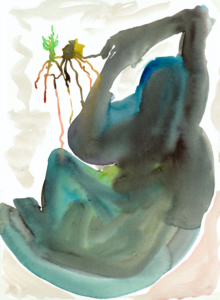
“This figure was a Gaia figure for Beloved. A spirit figure and a genuine person. I attempted with this piece to speak to the connection between self, open heart, and greater life, of expansion and growth.” –Samuel Paden
At the root of belonging and co-liberation is the living connection among the spiritual, ecological, social, and political realms. It is based on how our individual and group realities are just as multifaceted, multidimensional, and connected as the greater living systems of which we are a part. The components in this frame of beloved and be still are intrinsic to our nature as the type of living systems that we are.
We speak deeply to what it is we love, what and whom we care for, and what we find sacred. This area speaks to the practice of openness, openheartedness, expanding our circles of human concern, and committing to put it all into service. It is essential to understand that we are hardwired to experience this, both unconsciously and consciously, to maintain mutually beneficial relationships with each other and with the planet. Our collective health is guided by both spiritual and social well-being, and negatively affected by surplus suffering in both connected realms (john a. powell, Racing to Justice, 2011).
Beloved is not a romantic ideal. To love and to be loved can also be tough, grainy, and sharp. It can require putting up necessary boundaries, unearthing what is poisoning us, or deconstructing something creating excessive suffering.
This might mean taking the time to connect to a deeper purpose toward equity and belonging, articulating that purpose, and revisiting it regularly in meaningful and provocative ways.
Our health and well-being benefit from connecting to what we find sacred and actively embodying a greater interconnectedness. Such engagements can decrease the feeling and experience of social isolation. Research has shown us that the experience of social isolation and mortality is similar to the effects of cigarette smoking and mortality.
Social and collective spaces and practices that embody the beloved can improve our well-being by providing necessary social and emotional support, strengthening our collective sense of purpose in this work, and improve our nonverbal and socially intuitive abilities that call forth love in all of its forms. Shelly Tochluk describes in her book Living in the Tension: The Quest for a Spiritualized Racial Justice the context of how these practices occur and why it matters. Religious or spiritual practices can also be employed in power over ways, furthering the exclusion of those deemed others, worsening mental health.
Be still
“Going nowhere, as Leonard Cohen would later emphasize for me, isn’t about turning your back on the world; it’s about stepping away now and then so that you can see the world more clearly and love it more deeply.” Pico Iyer
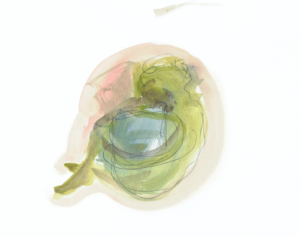
“The intention with this piece was to engender a sense of calm and reflection, and coming around what is important. The figure is folded inward, surrounding a circular object in the middle. This painting also speaks to the connection between Be Still and Beloved. Be-stilling is all about holding, connecting with, and caring for what we love and hold sacred.” –Samuel Paden
A crucial guiding principle of health and healing is that you must be more still than the thing in front of you that you seek to effect. This type of action, prioritizing this be stilling, is not typically rewarded in a world that emphasizes profit over people and which asks us to be complicit in our addiction to speed. We are taught to act on the fly and quickly.
Yet the amount of complexity in navigating the world today requires wisdom, not strategy alone. Developing skills around patience and creating informed actions from this space help make the best of our energy, resources, and time. Being still can help create more energy, energy of the most creative kind; the type of energy required during immense periods of change and turmoil. Being still is a constant struggle and involves attention to prioritize greater reflection and silence.
It is through the consistent practice of being still that we are able to touch what we have available to us and what is already present. A key and well-researched strategy for be still is for people to reconnect to the natural world, spending time with the other species that coinhabit the earth with us. Our nervous systems seem to recognize our interconnection with other species and can relax nonverbally into the living web. We find the core rhythm we have with other living systems to be mirror images of our own species as partners in something more expansive than any one thing.
There are direct ties to the well-being of our individual and collective bodies, and by employing in our work, we can better behold what we are striving to organize and support.
Being still slows down the part of the nervous system that stimulates our fight-or-flight responses (our sympathetic nervous system) and improves our abilities to rest and digest (our parasympathetic nervous system). We are better able to repair ourselves and eliminate our toxins. These processes are inherent to who we are as human beings. When we are out of balance, bringing about greater equilibrium in these ways not only better sustains our health but also helps us be the vehicles for social change we aim to be. Research from neuroscientists suggest that all models of social change could benefit greatly from a be-stilling space and practice as a part of the work.
Socially, there are great possibilities to integrating meaningful reflection and pause. Being still does not mean we remain in a state of inaction. We need our responses to be timely and accurate when it comes to responding to political infection and toxin. Anger and frustration are necessary emotions and movement builders, activating our organizing muscles and actions. Yet bodies are healthier if they are able to maintain balance. Prioritizing a grounding in mindfulness and stillness best helps the initiation and recovery from our mobilizing and change efforts. We improve our abilities to more accurately and holistically behold and take in situations and people in front of us when our collective and individual bodies are calmer.
Behold and Believe: The mapping and beginning structures of the tree
Behold
“You can’t be what you can’t see.” Melissa Harris-Perry
“The fundamental feature of every ‘now’ reveals itself, not in only what is past or what is present, but also in what is absent.” Ernest Bloch
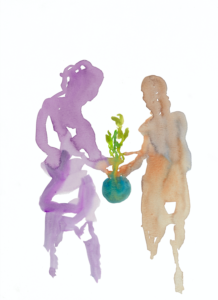
“This particular sphere is about decolonizing—holding what is in our view as living systems and not as dead and mechanical. The figures and the globe are all interconnected, highlighting the global nature of belonging and co-liberation, as well as oppression and othering. I deliberately cropped the beings at the perceived ‘ends’ of their body, as that space is critical to speak to ‘no beginning and no end.’ I also deliberately included different colors, shades, and the presence of androgyny. This shows how the dynamism of our identities enriches what we are able to Behold.”
–Samuel Paden
Our ability to mobilize and organize around the areas we care about and want to bring greater health to depends on our mapping of the areas and the issues themselves. Capitalism and supremacy run deep socially, and I am constantly shocked by how something so huge, so systemic can affect what we can see and understand in the first place before any related strategic action even happens. There are deep wells of anger and grief around witnessing these partial social lenses that are strengthened by historically perpetuated systems of oppression, misused power, and othering.
If we come from a grounded place of love and stillness, we can better hold what is in front of us, as a compassionate doctor effectively holds what a body is presenting to her in order to better understand its current condition, what led up to it being ill, and where to go from there in terms of healing strategies. Spiritual and social teacher Reverend angel Kyodo williams pressingly asks in her writings, “What is being left out? How do we better notice and identify where we enact superiority around who should experience greater life chances and health?”
Beholding applies not just to the structural conditions of the situation or topic but also to the emotional and relational balance present or not present. We are not adept at recognizing pain and suffering connected to social illnesses. To behold while grounding in spirit-based and liberatory practices calls for first touching base with beloved and be still. This will open up to a greater interconnectedness and resulting willingness to stop seeing things from conditioned perspectives and will calm our nervous systems socially and individually. We can better see, listen, and feel clearly from these spaces. Bearing witness to hope, as well as grief and anger, propels this work into the transformative by increasing our understanding of the suffering we hope to shift.
How do we embody the ability to literally behold what is in front of us and work toward greater well-being? How do we expand our frame by integrating decolonizing practices and multiple methods of knowing and learning, helping us move to a space of liberation and not toward simply a kinder, gentler suffering? Beholding for colonizing influences, as well as places of expansion and health, helps provide a more accurate map of change, including where our implicit biases play a role in the perpetuation of surplus suffering.
Key behold strategies also move us to push the edges around how strongly we place value on simple communication. While there is an elegance to conveying things in simple ways, as well as experiencing improved accessibility, we often misapply the “simple” rule and reward overly simplistic analysis, solutions, and approaches in order to increase our number of “likes,” for instance. What we behold is affected by our negative connotations to things we project and deem as overly complex, perhaps because they lay just beyond our realm of conditioned and perpetuated understanding. While I think all things can be better laid out in simple and engaging ways that speak to our overly stimulated minds, the processes and outcomes of belonging require us to be with multiple perspectives, to integrate some space for chaos and messiness, and to allow strategies to emerge from this.
Key racial equity-driven movements possess incredibly sharp lenses and analyses to better behold racial inequities and the contributing structures and practices to the undergirding systemic racism that roots it all. Examples of such analysis include the tool kits and processes put forward by the Government Alliance for Race and Equity, Race Forward, and PolicyLink. All of these groups have also been expanding their frames to integrate healing- and trauma-related content, practices, and questions, helping to more accurately behold what they are seeking to transform. And with this expansion, I look forward to these efforts and countless others to be more intentionally grounded in indigenous-based decolonizing analyses, leading to more accurately identifying and addressing systemic racism and oppression as well as their antidotes. Examples can be found in the work of Vanessa Andreotti of the University of Vancouver, British Columbia, and that of Sandew Hira of the Decolonial International Network.
Believe
“For the master’s tools will never dismantle the master’s house. They may allow us temporarily to beat him at his own game, but they will never enable us to bring about genuine change.” Audre Lorde
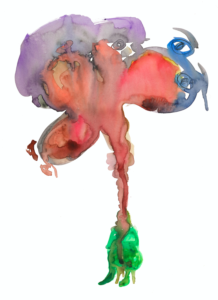
“The predominance of red and largeness of the form that are related to one’s beliefs speak to how much we are guided by what we believe and what incredible passion moves through us as a result. The presence of eyes as part of that Believe form above the head of the figure also speaks to the strong influence what we Behold has on our beliefs. The paint appears to be in motion, in the cloud formations above the figure, as well as into, out of, and through the figure, speaking to how dynamic and powerful our beliefs can be.” –Samuel Paden
Glenn Harris of the organization Race Forward shared the following astute observation: “You need ‘believe’ to be a part of this frame if you’re really going to address systemic racism.”
We collectively hold and perpetuate beliefs of superiority, which state that some people deserve to experience illness, poverty, and unequal chances at lives of ease. Such beliefs help inform the design of our social arrangements, keeping rigid racial and social hierarchies in place. Just as with the natural laws of our own personal bodies, our beliefs about the mappings of our social body and its anatomy influence how we move and how we think we can move.
Merely learning about belief systems that breed supremacy and superiority are not enough. Knowledge alone doesn’t interrupt or disrupt. This is something I experienced myself in my own professional work, complicit in promoting, for example, that educational sessions could help solve the issue as sole strategies. All the trainings and capacity-building sessions in the world won’t change the culture of racism alone. Such beliefs will still be present without, first, their thoughtful and consistent deconstruction and, second, the centering of beliefs that expand our collective imagination and promote well-being.
So how does what we behold relate to what we believe? What and how we behold affects what we believe and how fiercely our grip is on those beliefs. If we’re taking in partial information that goes unexamined, our beliefs will reflect that, and then our actions or inactions are partial as well and possibly even more harmful than we intended.
Somewhere between what we behold and what we believe are processes of noticing, attaching huge feelings to what we notice, and then crystallizing all of that into mental formations and, eventually, beliefs.
What are some practices in believe that can help us lead to greater belonging and co-liberation? For starters, we can intentionally build in practices that help us critically question and interrupt our conditioning and assumptions, both used with situations and people external to us, and those that guide how we view ourselves internally. This could look like creating spaces, just like in artistic processes, where we focus on looking at the things we’re working with from multiple perspectives. We turn it upside down, put it on its side, and engage people most affected by inequities to tell us what they see. We might find examples of superiority and inferiority. From here, our presence and willingness to change, which we’ve developed in be still, and our ability to more clearly behold help us shift such beliefs.
And just as important is connecting what we believe to what is beloved. How can what we believe about what guides us toward belonging and well-being be grounded in the natural laws of interconnectedness and in the connection between the social and spiritual? Grounding in such wholeness and sacredness is helped along by surrendering and de-emphasizing intellect-only approaches, which most often guide how we create and maintain our beliefs. Such surrender also helps our innate, as well as our constructed and learned, needs and obsessions to experience certainty at all times. Connecting believe to beloved involves engaging with multiple ways of knowing and being, allowing us to better engage with the unknown.
After all the years I’ve dedicated to working with racial equity, and doing so from within heavily bureaucratic and usually white-led hierarchies, the energy to sustain my contribution cannot be disconnected from my being a queer woman of color from an immigrant background, and one who has also struggled with chronic illness. Tarell Alvin McCraney shared in his keynote at the last Othering & Belonging conference that if we turn our attention to those who don’t want us or if we believe we—as communities of color, as queer people, as all the above—should not live, we leave unprotected our own people.
There can be real negative health impacts to working with people who believe we should not live, and within our movements, we need to get more strategic and real about how, with whom, and in what ways we work within oppressive structures.
This framework is unapologetically based on promoting an expansive ethics of caring. We are hardwired for connection. This is also true in relationship to human caring, having memories of caring and being cared for. The experience of such caring is connected to having an ethical response to bring about justice, for instance, or address inequities.
Becoming and Belonging, Co-Liberation, and Well-being: Branching, bridging, and embodying health
Becoming
“Having a deeper understanding of power and acknowledging the power that comes from spiritual practice and personal challenges can also increase our relevance to the communities we work with. We rarely use power-mapping techniques that include the power we get from within. This intellectual approach to landscaping power can unintentionally disempower our organizations and communities. While it’s hard to quantify spiritual or emotional power, leaving it out of the overall picture leaves little room for us to imagine ourselves as powerful.” Kristen Zimmerman, Neelam Pathikonda, Brenda Salgado, Taj James
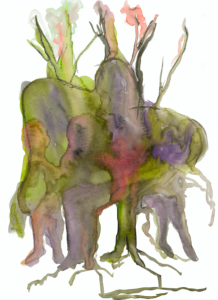
“Becoming doesn’t have results yet. It is sparse. But the figures are all in this space together. There is an engagement in a similar soil, although they are distinct, very much so. Some are connected, and some aren’t. There is a form of a tree that’s singular, but they’re part of that tree.” -Samuel Paden
Feedback from activists and advocates across sectors on this framework helped refine the concept. “What does spirituality and practice have to do with building power?” “Why should I care at all about a bunch of theory with no application?” “Show me why all of this is important.” I found it challenging to try and describe a connection that I had been culturally and spiritually taught was ever-present and self-evident, which could also only be described verbally up to a point. But research guiding the frame makes it clear that these areas of building power, activism, and spirit-based practice were inextricably linked.
Becoming, belonging, and co-liberation are inherently messy at times, nonlinear, and can elicit multiple perspectives that love and hate, and include and exclude, the emerging innovations and alternatives. This frame has both resonated with many people by providing more expanded views of change and ways of being to improve their work and turned people off who shared they felt the need to actively disengage with it. And then there were many people who said they just didn’t have the language to comprehend what they were seeing and reading, and wanted to learn more.
There are a few key learnings here. First, epistemic injustice has been perpetuated for centuries around splitting spirit from matter and spiritual suffering from social suffering. While the laws that protect us from the harrowing and negative effects of church integrating with state affairs are necessary, we seem to have also thrown out Beholding and embodying the positive health social and structural practices of meaning-making, connecting to purpose and what we love and hold sacred, and acting from a place of essential interconnectedness (Beloved).
Also, spiritual practices denying and not integrating social practice is a contributing factor. For many justice-focused people, not integrating spiritual practice that denied the realities of social and racial injustices was a protective factor and necessary in order to maintain the required focus on structural and systemic change to bring about greater belonging.
Lastly, language. Language can be used to exclude or include, often tied to desired outcomes and agendas that are not usually transparent. I have been complicit in these acts as well, as I imagine all of us have been. The tension is the desire for accessibility for the masses alongside the desire to what we commonly refer to as “speaking truth to power.” Of course that speaking is also influenced by our formal and informal schooling, experience of intersecting cultures, and our need to participate in the systems of capitalism in order to live.
Ultimately, I believe that if our feelings, thoughts, connections to what is sacred and to a greater interconnectedness, and beliefs are moving along the journey towards belonging and co-liberation, then our communications and actions will follow. We desperately need not just multi-verse, but pluri-versal decolonizing ways of talking, discussing, and enacting, and within that, leading with the voices of the most marginalized.
Becoming practices seek to deconstruct barriers and colonizing processes and support emerging alternatives to such colonizing realities. For those within bureaucratic systems, Becoming can look like “hospicing” the things that are dying, which are also harming our collective well-being and health, and “hacking” or breaking up and through oppressive structures and practices.
Building power and organizing economically, politically, socially, and spiritually are key to strengthening the branches and bridging structures in the tree of belonging. Such organizing is done, however, in a more supported fashion by grounding in what is Beloved and in the liberatory strategies of Behold and Believe. A key priority throughout would be the resiliency and well-being of all of us engaging in this work, if we elevate and focus on conditioning as an integral part of Becoming. One of my interviewees, a fifth-degree black belt, shared that people doing social and racial justice work need to condition ourselves. Most of the work of karate is about conditioning one’s mind, body, and soul for if and when a strike occurs. The art isn’t geared toward taking people out, but rather developing an immense preparedness and solid health in order to work through the fights.
Becoming is non-linear and dynamic, although still embedding strategic thinking, narrative, and action. Organizing movements that embed spirit-driven practices as defined in this article are growing; in the national and local scenes, we need to hold up these examples and strive to embody their learnings in order to more accurately achieve our social visions for belonging, and sustain our individual health and resiliency. Examples of these movements include: generative somatics trainings, healing justice strategies put forward by groups such as WorldTrust, transformative leadership sessions held by the Movement Strategy Center, yoga and equity initiatives, the collective strategies embodied by indigenous movements worldwide, and so many more.
Belonging, Co-liberation, and Well-being
“You cannot change any society unless you take responsibility for it, unless you see yourself as belonging to it, and responsible for changing it.” Grace Lee Boggs
“I define ‘politics’ as the ongoing collective struggle for liberation and for the power to create—not only works of art, but also just and nonviolent social institutions.” Adrienne Rich
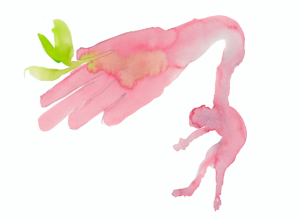
“Action is happening both up and down, in both the Belonging individual and Belonging collective [next page] paintings. In the collective one, there is looking at the tree and the results, but it’s not singular. There are all of these different voices and the state of living and being organic. What I was wanting to have concentrated in the visual is what’s happening in our communities. It’s not a singular person or thing, it’s multiverse.”- Samuel Paden
Aspects of this frame came to life as she was talking, grounded in what is beloved, decolonizing what they were beholding, and becoming in such a holistic, intergenerational way. Alone, each one of these aspects is not enough. But if approached and interacted with as an interwoven whole, they light up as a map toward the experience of greater social health and belonging, take shape, and self-animate. As we play with working models, such as this embodying belonging and co-liberation frame, it is crucial we take the time to reflect on our experiences and take in through all our senses what feels differently when enacted. By doing this sort of intentional and holistic reflection we solidify healthier ways of being, and going back to our old more destructive ways will be unthinkable (Dr. Darya Funches, Founder of REAP Unlimited, on the meaning of transformation).
Conclusion
“For to be free is not merely to cast off one’s chains, but to live in a way that respects and enhances the freedom of others.” Nelson Mandela
“We do not see things as they are, we see things as we are.” Anais Nin
Our shared work in justice-related efforts calls for us to renew, cocreate, and follow boldly emergent narratives and frames that urge us to embody belonging every step of the way. How we get there matters if we want to improve our overall outcomes while also sustaining and promoting positive health and well-being during the journey.
This is one of many emergent frames designed to embody the changes we want to see, including being structured as both a series of parts and as an interwoven working system and being informed by indigenous thought and multiple disciplines in content and implementation. In order to consciously not perpetuate existing structures of oppression, our work of becoming needs to branch from more structural analyses of what we believe and how we behold. This growth and movement will more greatly speak to our overall liberation and well-being if grounded in beloved and be still, or in the social and the spirit-based, and in what it takes to experience such interconnectedness. This frame strongly urges us to organize differently by integrating love and belonging at every turn.
The beauty and power of this frame is that it is already available to us—we are hardwired to love, to care, to mitigate harm, and to engage in multiple ways and systems. Indigenous peoples have been living this way for millennia, and many social and physical sciences also elevate the same premises. I invite you to explore and apply this frame to what is important to you and your communities and to constructively critique it, too. I hope it is supportive in fortifying your efforts and overall health as we move forward together, interwoven, toward greater belonging, and co-liberation.
A short note about the terms used in this essay
Epistemic injustice occurs when singular ways of knowing and being exist as a result of excluding and holding down other ways of knowing and being. Indigenous cultures have experienced surplus suffering as a result of this kind of injustice. Many of the words below and their definitions represent practices, outcomes, and strategies related to this type of injustice; I share them as the undergirding pillars for the analytical framework of embodying belonging and co-liberation that this essay attempts to define.
Spirit-based & spirituality
Spirituality may be most usefully understood as a noun of the original root of the word spir-, meaning “breath” or “purpose.” Research shows that when we are able to define purpose and meaning in life, we are the most connected to physical well-being. It is the reality of interconnectedness and wholeness (not perfection), as much as it is the journey to experiencing these. To that end, the yearning for and experience of this wholeness is deeply based on both the realities of living and of death and impermanence. Spirit-based practice is inseparable from social justice and, when realized, is “the highest form of political consciousness” (Kenny Ausubel, Bioneers, 2017). (Supporting sources: Shelly Tochluk, bell hooks, Joanna Macy, john a. powell, Pema Chödrön, Thich Nhat Hanh)
Co-Liberation
Liberatory-based language and practices have been centered from groups such as Black Lives Matter, the queer Chicana movement, Bioneers, and the Women’s March. I purposefully use co-liberation to account for the understanding of decolonial action and the belief, expressed by many activists, in a collective liberation that connects your freedom to mine, and mine to yours. Co-liberation calls for integrating self, community, and institutions toward a greater good. This definition requires an underlying belongingness; co-liberation is required for the social and spiritual connection to thrive. As Zadie Smith shares in the foreword of her recent book Feel Free: “You can’t fight for a freedom you’ve forgotten to identify.” (Supporting sources: Audre Lorde, Laura Perez, Ramon Grosfoguel, Lyra Butler-Detman, Robyn Avalon)
Belonging
Belonging is a state of enacting and being wholeness. It requires an expansive quality—the ability to zoom out and expand our circles of concern and care. Within the process of creating belonging is the need to eliminate or reduce the negative effects of harmful and oppressive structures. Equity-based strategies and decolonizing efforts are intrinsic to the work of belonging. Prioritizing the right to belong is vital in order to have a thriving and politically engaged populace, which informs distributive and restorative decision-making. (Supporting sources: Stephen Menendian and john a. powell, yoga sutras, Robyn Avalon, Vanessa Andreotti, Sharon Stein)
Health
The word “health” has roots in old Germanic and English, speaking to being “whole.” The word “heal” hails from these similar roots, speaking to “restoring to wholeness or sound health.” A movement toward wholeness is inherently present for us as living systems, both at the individual and collective levels. Our systems are built to stretch, tear down and repair, and heal in the movement toward greater wholeness and balance, which does not mean toward some idealized vision of perfection. Indigenous peoples for millennia have led with holistic representations of life, often referred to as the relational worldview model, which emphasize balance, sustainability, relationship, spirit-based practice, environmental well-being, and cultural cohesion. This evolutionary road map is intentionally grounded in this indigenous representation of health (which is also supported by the World Health Organization’s [WHO’s] definition of health), elevating and prioritizing actions and ways of being that speak to spiritual, mental, and social well-being, in addition to the physical. Mental and spiritual well-being and capacities are required for liberatory practices and movements to thrive. (Supporting sources: Terry Cross, W. K. Kellogg Foundation, Indigenous peoples’ movements worldwide, California Endowment, WHO, Centers for Disease Control and Prevention)
Colonization & Decolonization
The global modern project, or the “antilife project,” depends on a shadow side of violence and colonizing practices. Such practices seek to take and own land, and own how knowledge gets produced and what types of knowledge are rewarded. Often colonization is tied to economic gain, but not always over longer periods of time. From my Indian and Sri Lankan descent, I’ve learned about the devastating effects of British rule in India and Sri Lanka, which permeated not just the political and economic structures, but also the spiritual and cultural ways of being. A critique of using the word “decolonizing” is that such practices do not point us to where we want to be. Decolonizing in India has not been about simply removing the colonizers. A more holistic definition of the word calls for deconstructing and eliminating the toxins while promoting ways of being that lead to greater well-being and belonging. In government, it’s not just about identifying structural barriers and removing such practices and policies. It’s not just about thinking our way out of problems. It’s about undoing, letting go and letting die what needs to go and change, interrupting, and calling forth liberatory organizing-based solutions at all levels. (Supporting sources: Sandew Hira, Vanessa Andreotti, Sharon Stein, Decolonial Futures Collective, Sarah Ahmed, Kandi Mossett)
Power
How we define power and why we choose to do so is connected to our agenda and our purpose at hand. In a frame that is clearly linked to promoting well-being and health for all people while targeting the health inequities experienced by those who have been marginalized, power is seen as both a resource and as a pathway to greater well-being. Hannah Arendt has described power as the ability to not just act but to act in concert. Power as a resource is then a positive social good that needs to be distributed more equally in order to lead to more equitable decision-making and the deepened experience of agency at both the individual and collective levels. We are brought to analyze the ways in which broader political, social, cultural, and historical forces enable some individuals and groups to exercise power over others. Michel Foucault shares how power and knowledge are inextricably related: how creating and maintaining knowledge is an exercise of power and how power is always a function of knowledge. Here we see how knowledge can support further colonization and power over entire populations, with or without spoken intent to subjugate and control. Definitions of “power” that lead to well-being call for building power within (strengthening power within communities and individuals) as well as power with (strengthening power across various communities, levels of the constructed hierarchy, and other junior partners in the ecosystem). The National Economic and Social Rights Initiative calls for building power systemically by building a culture of solidarity, developing collective action, and creating participatory and accountable systems.

